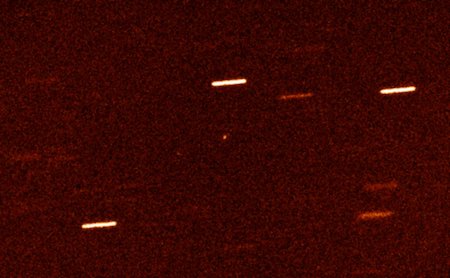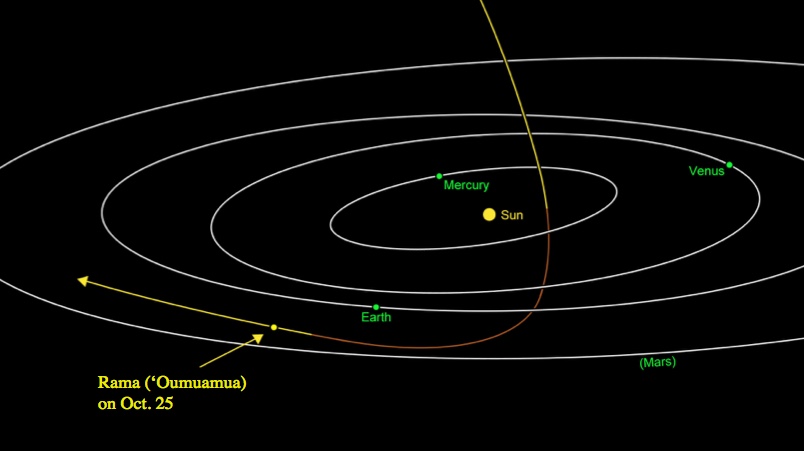Physicist: Good news!
On October 19th, for the first time in history, we detected an object inside of our solar system that originated somewhere else. It’s a rock the size of a stadium that passed inside of Mercury’s orbit and is presently on its way back out.
This is basically the plot of Arthur C. Clark’s seminal novel “Rendezvous With Rama” (sans aliens), which is about a thing from space passing really close to the Sun on a hyperbolic orbit before leaving the solar system. The International Astronomical Union has incorrectly chosen the name “ʻOumuamua” for our first known interstellar visitor, rather than the obvious, pronounceable, and generally superior name “Rama“. A rose is a rose is a rose, right up until the IAU gives it a weird name.

That dot in the middle is not from around here. The background stars are streaks because this is a long exposure by a telescope tracking with Rama. Everything we know comes from observations like this, so while we can determine speed and position, we have to estimate size and mass.
We can tell that Rama is new to the neighborhood because it is traveling far too fast to be gravitationally bound to the Sun. When it’s in interstellar space, Rama travels at 26 km/s (with respect to the Sun), which is about how fast other stars in our stellar neighborhood are moving. As it fell toward the inner solar system it gained speed until, at perihelion, it was a quarter of the distance from the Sun as the Earth and was screaming along at nearly 90 km/s. For comparison, once Voyager 1 has shaken the Sun’s gravitational pull, it will be traveling at about 13 km/s through interstellar space.

The path of Rama (or ʻOumuamua if you insist), the first observed interstellar object to pass through the solar system.
We know that Rama is rocky because it’s not producing a tail. Anything with lots of water ice boils when it gets close to the Sun. Rama is distinctly tail-free, which means that it’s an old, cold rock that’s having its first and last Summer for millions or billions of years.
Presumably, Rama is just one of many interstellar objects to pass through our solar system. We’ve been capable of detecting such objects for only a few decades and this one came remarkably close to us (several dozen Moon orbits, which is “close”). If it hadn’t been so nearby, we probably never would have noticed it. So if interstellar visitors are rare, then we are seriously lucky.
It has long been assumed that objects such as Rama should exist. During the early formation of a star system the new planets and moons follow chaotic, often destructive orbits. Not only do the young planetoids slam into each other, but near misses can fling asteroids, moons, and even planets out of a star system entirely. As recently as 1982, we’ve witnessed Jupiter rudely chucking a comet into interstellar space. The main reason things in a mature solar system (such as our own) follow such nice, clean orbits is that almost everything that didn’t stay in its own lane met a bad end a long time ago. So we can expect the interstellar void to be thinly populated by an unimaginable number of rejected asteroids and comets.
This is likely to be Rama’s backstory. It formed somewhere that wasn’t here, and was ejected from its home star system through an impact event or gravitational slingshot. The fact that it isn’t presently icy means that, for one reason or another, it spent enough time close to its parent star for all of its ice to boil off. It could be a very old comet or a native of an inner solar system. If we bothered to send a probe to catch up with it, we would be able to gain a lot of insight into the ancient chemical history of another star system. It’s been drifting around for so long that it may be impossible to say which star it calls home, but just knowing how another solar system might be different is a big deal. Fortunately, the movement of things in space is extremely predictable, so we’re not going to lose track of Rama anytime soon. Unfortunately, we’d need a rocket about twice as fast as New Horizons (the fastest rocket to date) to catch up with it.
Totally swinging wide: the existence of Rama gives a little more credence to the idea of lithopanspermia, the idea that life might travel between stars embedded in rocks. It has already been shown that some microbial life is perfectly happy in the cold, irradiated vacuum of space, and can even survive the massive accelerations involved in both ejection from, and falling onto, planetary surfaces. What hasn’t been shown (until now) is that those interstellar rocks exist at all. Spotting Rama in the sky is akin to living your whole life on a remote Pacific Island and seeing a (probably empty) boat for the first time. Exciting stuff!
The picture of Rama itself is from here.
The picture of Rama’s trajectory (slightly altered) is from here.
The blender picture is from here.








Pingback: Q: How hard is it to build a space elevator? What’s the point? | Ask a Mathematician / Ask a Physicist